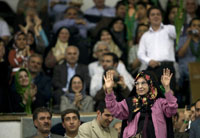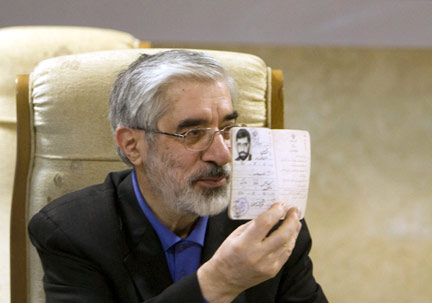Iran
Reform challenger shakes up presidential race
Article published on the 2009-06-09 Latest update 2009-06-09 16:10 TU
Mousavi, 68, is not a newcomer to the Iranian political scene. He was prime minister during the bloody Iran-Iraq war from 1980 to 1988, when the post was abolished in a constitutional reform. But since then, Mousavi has been enjoying the finer things in life. A painter and a poet, he established himself as a heavyweight in the Tehran intellectual and cultural scene.
Former reform President Mohammad Khatami, who governed for two terms before Mahmoud Ahmadinejad’s surprise victory in 2005, has pulled out of the race to support Mousavi, saying that he was afraid of splitting the reformist vote. This high-profile nod was reinforced by strong support among the Friday prayer leaders across Iran.
But political endorsements only establish Mousavi as a contender. What really sets him apart is his modernity, his mass support on the internet, his use of western music in campaign ads, and the colour green.
Often seen as a refuge for political dissent, social networking sites like Facebook are becoming key battlegrounds in the race for the next president. 60 per cent of Iran’s population is estimated to be under 30, and they are avid users of portable phones, blogs and the Internet. Thousands of messages are traded back and forth between Mousavi supporters everyday on Facebook and election rallies are announced on the website after it was re-opened by government censors in early June.
Mousavi also took the step of creating a symbol for his candidacy. He chose green, the colour of Islam and of Iran, to represent his campaign, and no sooner did he do so, the other candidates were scrambling to catch up. Ahmadinejad picked red, white and green, the colours of the Iranian flag, and began distributing bracelets to his supporters. But this has paled in comparison to the wave of green headscarves, green t-shirts and banners that are popping up around the country.
On Facebook, one Mousavi support group has more than 6 thousand members who have applied a green filtre to their profile pictures to proclaim their fidelities.
Finally, Mousavi’s wife, Zahra Rahnavard, has become a prominent fixture on the campaign trail, accompanying her husband to rallies and speaking before amphitheatres packed with enthusiastic students. While women do play a significant role in Iranian society, and are considered equal under the constitution, they remain a small minority in politics.

Zahra Rahnavard, Mir-Hossein Musavi's wife speaks at a rally in Tehran, 23 May 2009.
(Photo: Reuters)
Rahnavard, who holds a PhD in political science, recently took centre stage in the campaign after a firey debate between Ahmadinejad and Mousavi, where the president called into question the legitimacy of her degrees. She has threatened to take legal action against the president if he does not apologise and has galvanised the support of many urban women around her husband’s candidacy.







